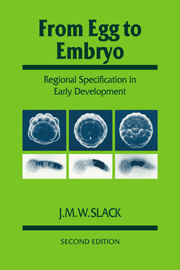Book contents
- Frontmatter
- Contents
- Preface to the second edition
- Preface to the first edition
- 1 Regional specification in animal development
- 2 The concepts of experimental embryology
- 3 Theoretical embryology
- 4 Hierarchies of developmental decisions
- 5 Development with a small cell number
- 6 Models for Man: the mouse and the chick
- 7 The breakthrough
- 8 What does it all mean?
- Appendix: How to write a program for development
- References
- Index
4 - Hierarchies of developmental decisions
Published online by Cambridge University Press: 16 October 2009
- Frontmatter
- Contents
- Preface to the second edition
- Preface to the first edition
- 1 Regional specification in animal development
- 2 The concepts of experimental embryology
- 3 Theoretical embryology
- 4 Hierarchies of developmental decisions
- 5 Development with a small cell number
- 6 Models for Man: the mouse and the chick
- 7 The breakthrough
- 8 What does it all mean?
- Appendix: How to write a program for development
- References
- Index
Summary
XENOPUS AND OTHER AMPHIBIANS
Because of the many technical advantages which they offer, amphibian embryos have been a favourite material for the experimentalist for over 100 years. The eggs are large, usually 1–2 mm in diameter, and develop from egg to tadpole outside the mother so remaining accessible to experimentation at all stages. This makes them particularly suitable for micro-operative procedures. In addition, as we shall see below, fragments of early embryos and even isolated cells are able to continue development if incubated in simple salt solutions. This is possible because every cell in the embryo contains a supply of yolk platelets which serves as its nutrient supply until the larval blood circulation becomes established. Recent years have seen intense activity involving the combination of the longstanding microsurgical techniques with cell lineage labelling and the techniques of molecular biology.
Although many different species have been used for experimental work in the past, the African clawed toad Xenopus laevis is now the world standard amphibian for the study of early development because of its ease of maintenance, ease of induced spawning and robustness of the embryos. Other laboratory species such as Rana pipiens, the American leopard frog, and Ambystoma mexicanum, the axolotl, have become much less important.
- Type
- Chapter
- Information
- From Egg to EmbryoRegional Specification in Early Development, pp. 67 - 127Publisher: Cambridge University PressPrint publication year: 1991
- 1
- Cited by

